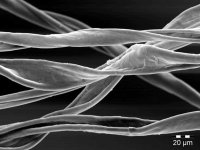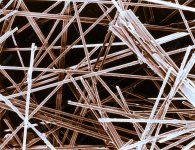I've just lined my desktop speakers with thin egg-box foam. I admit the speakers sound less boxy. There's less bass in the 100-200Hz region. But I remain sceptical. Doesn't the foam simply reduce cabinet volume?
It's confusing. I've taken apart hundreds of speakers. Some manufactures stuff their cabinets with damping and wadding like the they bought it in a fire sale, others use none.
It's confusing. I've taken apart hundreds of speakers. Some manufactures stuff their cabinets with damping and wadding like the they bought it in a fire sale, others use none.
When used at a certain rate, such as when closed boxes are stuffed, the damping actually increases the effective box volume.
Ported boxes are a special case and traditionally builders don't want to damp the bass the box worked so hard to achieve... however if you have box modes, they could possibly be a higher priority.
Ported boxes are a special case and traditionally builders don't want to damp the bass the box worked so hard to achieve... however if you have box modes, they could possibly be a higher priority.
Ported enclosures traditionally only have absorbent material attached to the internal walls of the enclosure.
Placing stuffing in the body of a ported enclosure impedes the transfer of energy from the vibrating woofer to the plug of air in the port.
The absorbent material on the walls of a ported enclosure is basically transparent to bass frequencies so does not reduce cabinet volume.
Placing stuffing in the body of a ported enclosure impedes the transfer of energy from the vibrating woofer to the plug of air in the port.
Doesn't the foam simply reduce cabinet volume?
The absorbent material on the walls of a ported enclosure is basically transparent to bass frequencies so does not reduce cabinet volume.
Reduce internal resonances (and standing waves), lower woofer FS and enclosure tuning, improve time domain response, lower impedance spikes to make a cohesive amp/woofer/enclosure acoustic system, more efficient load to some amps.
In large vented reflex speakers/Ultraflex/Onken it also keeps lots of higher frequency stuff from exiting through the ports. I have Onkens and I have lined 3 walls with mostly lambs wool/felt. Guaranteed >70% lambs wool, no idea what else is in there, but it really helped with combing at the top of the woofer's passband and with harmonics.
Lining the internal walls of a ported enclosure with absorbent has the function of reducing higher frequency reflections and standing waves.
However, excessive padding will take the life out of the reproduction.
It is sometimes better to line one wall and leave its opposite number unlined.
However, excessive padding will take the life out of the reproduction.
It is sometimes better to line one wall and leave its opposite number unlined.
I found lining 3 walls ideal, they are bottom, one side and the back. I don't typically run the woofers beyond 800Hz, and currently crossing at 700Hz., really helps with reflection generated garbage. I don't find acoustastuff or fiberglass nearly as effective.
This is a common subjective assessment but the words don't do justice to the situation and tend to be misleading.excessive padding will take the life out of the reproduction.
That was a non-technical description.
I'm happy to leave the technical intricacies to you.
I might even learn something!
I'm happy to leave the technical intricacies to you.
I might even learn something!
The fibres move with the sound and turn it into heat.. they reduce sound in the back of the cabinet and damp resonances.
Yes, interesting. I think that's because the wall lining is particularly good at reducing internal reflections (echoes). Whereas stuffing is better suited to damping cavity resonances, as it resides centrally, as well as near the walls where it's far less effective (think damping a guitar string along its length, compared to at the bridge).I found lining 3 walls ideal, they are bottom, one side and the back. I don't typically run the woofers beyond 800Hz, and currently crossing at 700Hz., really helps with reflection generated garbage. I don't find acoustastuff or fiberglass nearly as effective.
Of course, polyester stuffing is notably useless anyway, as its energy absorption is limited by the fact that its fibres are smooth (unlike wool and fibreglass). (It still may be useful as a means of increasing effective box size though - especially in the case of closed-box subwoofers.)
As for best lining material, I would imagine very thick natural fibres would be best, though I haven't done any comparisons.
I think that's because the wall lining is particularly good at reducing internal reflections (echoes). Whereas stuffing is better suited to damping cavity resonances,
I agree. Lining the internal walls of a ported enclosure reduces internal reflections which could emerge through the woofer cone or port opening and has little to do with the suppression of resonances.
I also agree that natural fibres, because of their random orientation and texture, make the best absorbents.
However, I wouldn't place fibreglass in the same category as wool or cotton - see attached photomicrographs.
Attachments
Not if it's open cell. Closed cell, yes: it's just taking up volume & is useless for acoustic damping purposes.Doesn't the foam simply reduce cabinet volume?
The 'others' are likely saving money. But it depends on the design. Efficient design is about doing the most with the least -that doesn't necessarily mean 'none' of course. For a regular, well proportioned vented box, typically something like 1in OC-703 bonded acoustic fibreglass board on non-opposing faces should be sufficient to handle reflections etc. -either measure (ideal) or use the old click test to ensure a nice clean impulse. For a box where one dimension is stretched sufficiently to the others (or just a rather large box) for the longitudinal mode to become problematic, then stuffing around Vmax is usually the most effective solution. TLs by intent, or acoustically undersized boxes using stuffing for a 'vitual Vb increase' are different matters of course.It's confusing. I've taken apart hundreds of speakers. Some manufactures stuff their cabinets with damping and wadding like the they bought it in a fire sale, others use none.
For the measured effects of a few different materials: http://diyaudioprojects.com/Technical/Papers/Loudspeakers-on-Damped-Pipes.pdf
Fibreglass man myself, when possible. Otherwise SAE-F10 wool felt or an equivalent thereof. BAF isn't catastrophic -it just isn't as effective as some, so you do often need to use more of it.
The original posters question was about stuffing in a ported box, not lining a ported box. Is there a place where I can find a definitive answer? Some say use some stuffing and some even stuff ports to tune the speakers.
Any stuffing, be it lining on the walls or pillow inside, will cause loss with the helmholz resonance reducing the low end boost the port gives. On the other hand you likely want some stuffing, or lining, to reduce unwanted resonances higher up in frequency, which color the soudn if too bad. What is enough depends on million things, but in the end you want as little stuffing as possible to have max gain boost on lows from the Helmhoz resonance. Hope it helps.
many very cheap speakers have inside no damping at all maximizing output at the cost of clear sound.
some manufacturers stuff a little bit a reflex box with some wadding cause its easy to do (saving time) losing some bass, but not too much. Impulse response suffers due to moving baf wadding (the white stuff)
My Celestion DL4 in the 80ies was damped like this.
Most manufacturers know that damping the walls with foam is the choice.
Best is lining all surfaces minimizing the middle tones. The foam should be well fixed for best bass reproduction.
Here Visaton on the effect of damping boxes
some manufacturers stuff a little bit a reflex box with some wadding cause its easy to do (saving time) losing some bass, but not too much. Impulse response suffers due to moving baf wadding (the white stuff)
My Celestion DL4 in the 80ies was damped like this.
Most manufacturers know that damping the walls with foam is the choice.
Best is lining all surfaces minimizing the middle tones. The foam should be well fixed for best bass reproduction.
Here Visaton on the effect of damping boxes
Visaton Germany measured stuffing of closed boxes
https://www.visaton.de/de/service/technische-grundlagen/bedaempfung-von-gehaeusen



https://www.visaton.de/de/service/technische-grundlagen/bedaempfung-von-gehaeusen
theoretical maximum gain due to reflex loading a box:
+6db
any damping minimizes this output by some decibels until reflex loading ceases due to a completely stuffed box.
And impulse response suffers. In this case the damping generates nonlinear distortion what worsens the sound.
If you need lots of damping its better to make the box closed or change the box size for example.
+6db
any damping minimizes this output by some decibels until reflex loading ceases due to a completely stuffed box.
And impulse response suffers. In this case the damping generates nonlinear distortion what worsens the sound.
If you need lots of damping its better to make the box closed or change the box size for example.
here is an example of stuffing in a ported box. http://www.troelsgravesen.dk/SBAcoustics-3WC.htm . But I see that a test box is in order. I can see that it is a matter of driver, box size, and desired outcome.
As mentioned, lining a ported box is mostly to reduce standing waves. Unfortunately, open cell foam is the least effective material. I have quite a bit of "mattress topper" material from Walmart from my cost-cutting days, but now I always go with something like Denim/cotton material.I've just lined my desktop speakers with thin egg-box foam....
- Home
- Loudspeakers
- Multi-Way
- The Effects of Damping a Ported Cabinet

